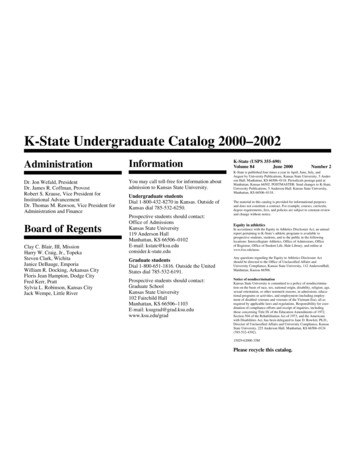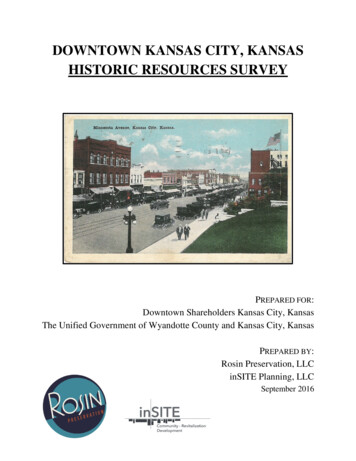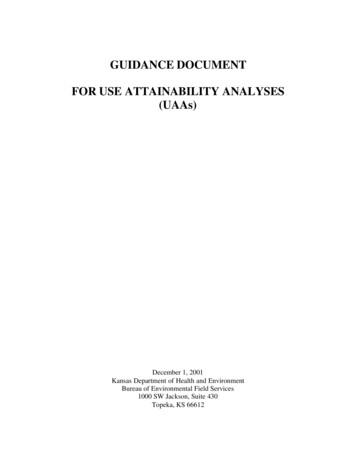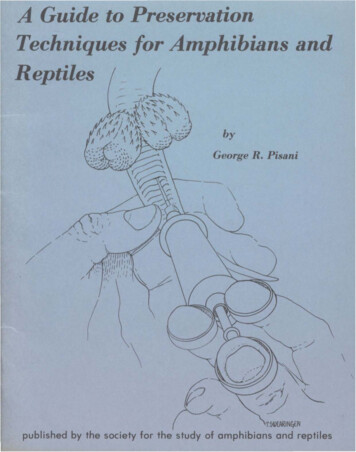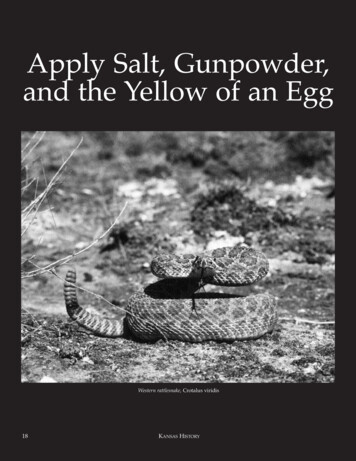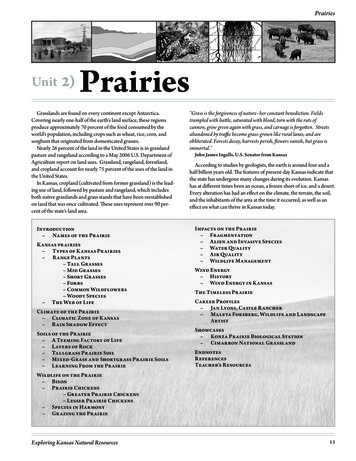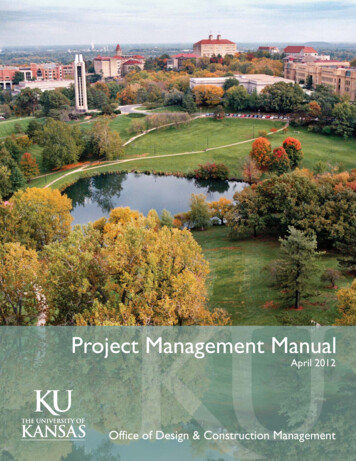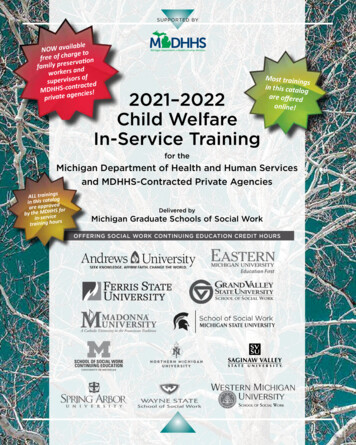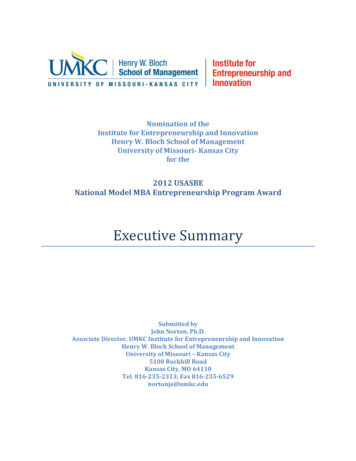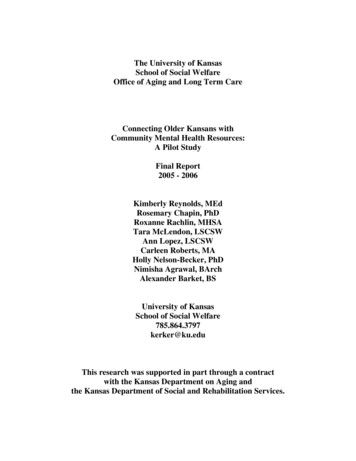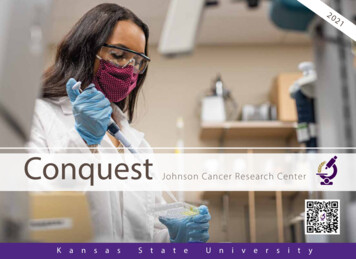
Transcription
20ConquestKansasS tJohnson Cancer Research Centera t eUniv ersity21
100%of donated funds stay atK-State to support cancer research and educationand the university. 563,14690was awarded in2020 for faculty and student cancer researchand training.faculty researchers are fighting cancerin 20 departments of 5 colleges.Cancer Research and Education Advisory CouncilTrent Armbrust, M.S.Manhattan, KansasBrent Benkelman, D.D.S.Manhattan, KansasWebster Cavenee, Ph.D.San Diego, CaliforniaBryan Costantino, MBA, M.S.Naples, FloridaEdie DahlstenLindsborg, KansasHank Doering, M.D.Manhattan, KansasLeigh Eck, M.D.Fairway, KansasKent GlasscockManhattan, KansasJames Haymaker, MBAKey West, FloridaMary Jo Heyka, R.N.Council Grove, KansasMike andElaine Jacobson, Ph.D.sFort Worth, TexasKen JennisonSalina, KansasBill Snyder, M.A.Manhattan, KansasAnn Clow SwirczynskiAubrey, TexasSarah Young, Ph.D.Clifton Jones, M.D.New York, New YorkRobert Kinders, Ph.D.EmeritusHarvey McCarterFormer Kansas Gov.John CarlinTopeka, KansasWalkersville, MarylandUSAFR, Ret., Fairview, TexasRobba Moran, J.D.Manhattan, KansasBrian Olsen, M.D.Overland Park, KansasLorene OppyManhattan, KansasSandy RegierOverland Park, KansasScott Rottinghaus, M.D.Dover, MassachusettsManhattan, KansasR. Clay Harvey, M.D.Topeka, KansasBeverly LueersTopeka, KansasAlbert Perry, M.S.Potomac, MarylandEd Petrik, M.D.Topeka, KansasJames and Cibyl RonenSt. John, KansasScan this QR code to give online.The fight starts here!From nanoparticles and stem cells to antioxidants and drugdiscovery, Kansas State University faculty are conducting the basicand translational cancer research that leads to new treatmentsand cures, as well as training tomorrow’s scientists and medicalprofessionals. To support the Johnson Cancer Research Center’svision to conquer cancer in our time, you can donate online atksufoundation.org/cancer or by using the QR code above. With yourhelp, we make a difference! To learn more about how youcan support K-State cancer research and education, visitcancer.k-state.edu/support or call 785-532-6705.On the cover: Kierra Holloman, junior in biochemistry and Cancer Research Award recipient, Kanost Lab
When thinking back on 2020, we tend to remember COVID-19 with masks, socialdistancing and quarantines. But I also remember meeting amazing supporters of theJohnson Cancer Research Center. I met many new friends — some in one-on-onemeetings and phone calls, others at large events like the You’ll Never Run Alone5K. Many became virtual friends at community outreach events like the Pink PowerLuncheon, where over 80 people met on Zoom. Together, these friends showed mefirsthand how many amazing people support us.Table of contentsEveryone seemed to realize that even in the midst of a pandemic, cancer doesnot stop! As this issue of Conquest demonstrates, support of the Johnson CancerResearch Center continued in 2020. With your help, the Johnson Cancer ResearchCenter funded over 555,000 of cancer research awards. Despite the COVID-19related restrictions, we sponsored research awards for graduate and undergraduatestudents and faculty members. We also supported an initial collaboration on cancerprevention and the Pancreatic Cancer Research Collaboration of Excellence, or CRCE.As vaccinations become more available, our laboratories will return to their vibrantactivities with students, postdocs and technicians working together to cure cancer.Biologist’s cell movement research couldpave way to new brain cancer treatment2Beyond the classroom3Waves over knives4K-State alumna, OB-GYN says student researchexperience opened doors to success6Veterinary oncologist fights cancer in pets7Self-proclaimed “medical miracle”shares her story at Pink Power LuncheonEven during COVID, our donors continued to support our center, as exemplified bythe Flossie West trustees. Their gift is advancing Dr. Anna Zolkiewska’s breast cancerimmunotherapy research.8We also show how your support of undergraduates advances their careers. Aftergraduating from K-State in 2004, Kristy Morales went on to become an OB-GYN.Kierra Holloman, a junior in biochemistry, plans to apply her cancer researchexperience in medical school.Leaving a legacyinside back coverThis Conquest showcases how faculty and students leverage your support intoadditional funding and advancement. You will read how Dr. Jocelyn McDonaldleveraged her JCRC award to obtain a national award to study how brain tumorsmetastasize to other organs. After initial funding through the Pancreatic CRCE, Dr.Punit Prakash received significant national funding to develop nonsurgical alternativesfor removing tumors. As a veterinarian, Dr. Mary Lynn Higginbotham is partnering on aproject to treat melanoma while her bone cancer clinical trial is actively enrolling dogs.Thank you to everyone who has made this year possible, from donors andfaculty to administration and the amazing JCRC staff. I hope to meet moreof you soon! Together, we will use basic science research to fight cancer.1 Chalmers Hall, 1711 Claflin Road, Kansas State University, Manhattan, KS 66506-3901785.532.6705 cancerresearch@k-state.edu h cerresearchSherry D. Fleming, Ph.D., Director and Fiedler Chair
4,034,066has been invested in promising cancer research projectssince 2003. But 6,096,895 has been requested.Biologist’s cell movement research couldpave way to new brain cancer treatmentOne of the biggest problems with cancer cells is that they move away from theiroriginal location and invade other parts of the body. This spreading of cancer cells,called metastasis, can be devastating for patients.Jocelyn McDonald, associate professor of biology at Kansas State University,is working to understand how cells break off from tumors, move through thebloodstream and invade distant organs. She is using the fruit fly as a modelorganism to identify the genes that drive this process. Fruit fly genes aresimilar to those in human cancers.“Tumor cells invade as single cells and as cell groups, or collectives,”McDonald said. “We’re investigating the mechanisms that drive themto invade collectively, which accelerates disease progression.”Currently, her team is focusing on glioblastoma, the most commonmalignant brain tumor. According to McDonald, expression of theadhesion gene α-catenin in glioblastoma patients correlates withpoor survival. Her team is investigating whether, and how, α-cateninpromotes collective invasion and metastasis. They are doing this inboth the fruit fly and cultured human glioblastoma cells.“We believe that α-catenin and associated proteins could bepotential therapeutic targets for developing drugs to treatglioblastoma,” McDonald said. “This is important because thereare very few treatments for glioblastoma and standard care hasa very low rate of survival beyond five years.”2By Marcia LockeThe Johnson Cancer Research Center provided a 25,000 InnovativeResearch Award for this work in fall 2019. These awards provideseed money for preliminary investigations that hold great promisefor garnering future extramural funding.McDonald has already leveraged her award into a 938,885National Science Foundation grant. She and co-principal investigatorBrad Olson, associate professor of biology, are conducting the study,“Coordination of collective cell migration in complex tissues.” Theaward also supports science workshops for secondary school girlsand a project with K-State engineering students to design and createa tissue-altering device and study its effect on cell group movement.Training students is important to McDonald. She has mentored12 undergraduate students and three graduate students sincecoming to Kansas State University in 2015. This includes threeundergraduate JCRC Cancer Research Award recipients and oneJCRC Graduate Student Summer Stipend recipient.“I love working with students and am proud that almost all of minehave continued on to medically related or science-related careers.”“We’re really appreciative of the cancer research support,”McDonald said. “It helps us to work on projects that initially aredifficult to get funded because they need preliminary data. It’s alsobeen wonderful to have support to train more undergraduate andgraduate students in the lab.”
Beyond the classroomBiochemistry student works on molecularswitch to kill cancer cellsBy Marcia LockeKierra Holloman knew before she enrolled at Kansas StateUniversity that she wanted to work with DNA. The ambitiousFort Worth, Texas, native has been working in a laboratory sinceher freshman year at K-State. Now, the junior in biochemistry isdirecting her research toward fighting cancer.Holloman works in the laboratory of Michael Kanost, universitydistinguished professor of biochemistry and molecular biophysics,under the supervision of Neal Dittmer, research assistant professorin the same department. She was excited to join this team becausethey work with DNA.Holloman started out studying the use of double-stranded RNA toalter gene expression. Now, with a Cancer Research Award from theJohnson Cancer Research Center at K-State, she is zooming in onproteins involved in cancer.Specifically, Holloman is studying proteases and serpins. Proteasesare enzymes that break down proteins, and serpins are a type ofprotein that can inhibit proteases. This is important to cancer researchbecause a protease in humans, called granzyme B, can promoteprogrammed cell death, or apoptosis, in various types of cancer cells.And a protein called SerpinB9, which regulates granzyme B, caninterfere with that process, allowing the cancer cells to survive.The function of SerpinB9 can be blocked, however, by disulfidebonds formed through oxidative stress. So, in her study, “Regulationof protease inhibitors by oxidation of cysteine residues,” Hollomanis investigating how a serpin can be turned on or off by oxidationreactions. Using an insect serpin similar to human SerpinB20, sheis studying how oxidative stress can cause formation of disulfidebonds between serpins and other molecules.“What’s especially exciting is that our method for forming thebonds between the serpin and cysteine or glutathione — if it cantranslate to human serpins — would be a discovery of a newmechanism for regulating serpins that have a role in cancer cellsurvival,” Holloman said.Holloman is grateful for this extensive research experience.“I think the way this most helps me is in my classes,” Hollomansaid. “I’ll find myself in class thinking, ‘Oh, I’ve done this in my lab’or ‘my mentor talked to me about this.’ It has helped my grades alot, getting that hands-on experience. I also think it gives me a stepup in my future because I want to work in a lab and I’m alreadygetting experience using the equipment.”She is also grateful for the financial support of the Cancer ResearchAward.“Doing all these classes and exams and lab work is stressful; I don’tknow how I’d be able to have another job,” Holloman said. “Andthis is nice because it’s an academic job, so you’re learning at thesame time as getting help paying for rent and food.”Making Holloman’s research even more meaningful is that hermother is a cancer survivor. A few years ago she had a thymoma, arare cancerous tumor in the thymus, an organ of the immune system.“My mom is super-excited about my project,” Holloman said. “Shesaid it makes her proud to know I’m working on cancer research.”Holloman attributes much of her interest in laboratory research toher Richland High School forensics teacher.“Mr. Sanders’ class helped me figure out that I liked DNA analysis,which led me to do biochemistry and now cancer research,”Holloman said. “I still thank him to this day.”After she graduates from K-State, Holloman plans to go to medicalschool to study biomedical forensic science. Until then, she’ll beworking hard to kill cancer cells in the lab. 200,000a year is dedicated to trainingstudents to do research.3 1,741,000has been invested in undergraduateresearch training since 1980.
7,891,773in NIH funding was won by our faculty in2020, often leveraging our seed grants.Waves over knivesEngineer develops energy-basedalternative to tumor surgeryBy Marcia LockeIdeally, cancerous tumors can be removed with surgery. But in manycases, they can’t. The tumor is too big or inaccessible, or the patient isunable to tolerate surgery. Minimally invasive alternatives are needed.Punit Prakash, associate professor of electrical and computerengineering at Kansas State University, is developing technologiesfor minimally invasive treatment of localized cancers, or tumors.Specifically, his team is developing energy delivery devices andstrategies for thermal therapy of cancer. They work primarily withmicrowave and radio-frequency energy.4
55,814Thermal therapy involves precisely depositing energy into the targettissue where it is absorbed and converted into heat. It can be donein a couple of ways. One is to intensely and briefly heat tumors todestroy them, called thermal ablation. The other is to moderatelyheat tumors for longer durations to increase their blood flow, whichcan have various effects that synergize with other therapies.“With our thermal ablation therapy, the idea is to go in anddestroy that solid mass or tissue without as big of an incision, andhopefully even without general anesthesia,” Prakash said.Prakash and collaborators are working to improve tumor ablationtechnologies currently used with cancers in the liver, prostate, lung,kidney, other organs and bone. The team’s image-guided device betteraddresses the challenges of energy delivery, direction and dosing.The moderate heating approach stimulates tumors, which typicallyhave irregular blood flow. The increased blood flow could helpget more chemotherapy or immunotherapy drugs into the tumor.Similarly, it could amplify radiation therapy within the tumor as well.To carry out these therapies, Prakash’s team has developed aneedle-based device about two millimeters in diameter that canbe inserted through the skin and into a tumor with guidance fromMRI technology.“The goal is to maximize therapeutic heating of the tumor whilepreventing thermal damage to critical structures,” Prakash said.“Our device radiates the microwaves in a pattern so they localizewithin and slightly beyond the tumor with minimal disruption ordamage to surrounding tissue.”Prakash’s team has also made the device capable of shaping thepattern of the energy that is radiated.“Instead of going off in all directions, it heats only to one side,so clinicians treating close to a critical structure can aim theenergy away from it,” Prakash said. “This technology is now beingtranslated by a Manhattan-based startup company founded by arecent K-State graduate.”Since MRI also monitors temperature in real time, energy dosing —or measuring and controlling how much the tumor is heated — isintrinsic to Prakash’s technology.“Working in the MRI environment is tricky because of theassociated risks, but we are focused on producing a closed-looptreatment that can deliver energy while simultaneously monitoringand correcting it,” Prakash said.Prakash, who leads K-State’s Pancreatic Cancer ResearchCollaboration of Excellence, thinks that his technology offers somehope for pancreatic cancer patients, who are often diagnosed after5supported laboratory equipment purchases in 2020.But hundreds of thousands of dollars are needed.their tumors are too advanced for surgery. According to Prakash,thermal ablation could shrink the tumors so that they’re eligible forsurgery and moderate heating could augment nonsurgical therapies.Prakash appreciates the support he has received from the JohnsonCancer Research Center and has leveraged his awards to garnermillions of dollars in extramural funding.”The JCRC funds are really helpful,” Prakash said. “Initially, youmight think it’s a small amount, but it’s critical because it helps yougenerate the next level of evidence that helps you apply for thebigger funding.”Indeed, Prakash and partners received a 1,321,648 NationalCancer Institute grant to develop a bronchoscopic microwaveablation system for lung tumors. According to Prakash, microwaveneedles are effective, but since lungs can collapse, a saferapproach to lung tumors may be from inside the airways, whichare difficult to navigate. He and collaborators have developed asystem that is showing success in animals and may advance tohuman testing by next year. This work has resulted in multiplepending patent applications.“This has been really exciting for us,” Prakash said. “It’s not everyday you’re involved in developing a new technology from conceptto clinical translation.”
75%of undergraduate CancerResearch Awardees go on tograduate and professionalschools, and many of the rest gointo the biomedical workforce.K-State alumna, OB-GYN says studentresearch experience opened doors to successBy Marcia LockeFrom delivering babies and performing surgeries toconducting wellness exams and counseling nervousmoms-to-be, Kristy Morales, an OB-GYN and afairly new mom herself, leads a busy life helpingpeople. The 2004 Kansas State University graduatein biology and pre-medicine works in Texas and shecredits her undergraduate research experience withhelping her become a doctor.Morales grew up in Manhattan, Kansas. Sheremembers walking to K-State’s Hale Library withher mom, a graduate student at the time, andadmiring the beautiful campus with its strikinglimestone buildings. She loved Manhattanand after graduating from Manhattan HighSchool, she stayed to attend K-State.Morales worked in the laboratory of Lorena Passarelli,professor of biology. They studied baculovirus, a virusused in biomedical research as a vector to producevaccines, diagnostic agents and therapies.Now a busy OB-GYN at South Texas HealthSystems Women’s Corner in Edinburg, Moraleslooks back with gratitude for the philanthropythat helped her get there.Morales received two Cancer Research Awardsfrom the Johnson Cancer Research Center. Theawards provide funding to support facultymentored research experiences for students.She investigated a protein complex involved inviral replication, seeking insight that could helpoptimize baculoviruses as gene therapy vectors fortreating cancer and as powerhouses for vaccinedevelopment.“The Cancer Research Award from the JohnsonCancer Research Center made it possible forme to finish my research project and continuepursuing my career,” Morales said. “Without thatsupport and experience, I don’t think I would’vebeen as strong a candidate for medical school.”“Doing that research gave me experience workingas part of a team, critically reading journalarticles, and presenting and publishing scientificwork,” Morales said. “It was a good experienceoverall. It opened doors for networking and ithelped me a lot in med school to have that baseof knowledge from the lab.”That was one of several decisions that setMorales up for success. With thoughtsof going into psychology, she alsolistened to her advisor, Larry Williams,and majored in biology, which wouldprepare her for medical school inpsychology or anything else. Shealso took the advice of Anita Cortez,then-director of the DevelopingScholars Program, to get involved inresearch, which would help her nomatter what she went into.In fact, during her first year of medicalschool, her laboratory mates remarked on herexceptional skills.“They asked me, ‘How are you so good at that?You’re using those pipettes like a boss!’” Moralessaid. “I told them I did it in undergrad. I wasn’tthis good when I first started; I just know how touse the machine.”They were right. Morales lovedbiology and soon ruled outpsychology, added pre-medicine,joined a research team andaimed for medical school.After earning her medical degree in 2008 fromCreighton University School of Medicine inNebraska, Morales did her medical residency atSaint Louis University Hospital in Missouri and thenserved four years as an OB/GYN in the U.S. Air Force.Meanwhile, her husband started medical school too.In 2017, his residency took them to Texas.Kristy Morales6Things are going well for Morales and her familyin Texas. But she will always treasure her time atK-State — in the Division of Biology and the lab —and is grateful for all the doors it opened.
Programs to advance K-State cancer research andeducation are made possible by private donations.and I, along with all of the oncology group at the Veterinary HealthCenter, have worked together to justify the dog as a model, and onin vitro work comparing the tumor cells and the effects that variousnanoparticles have on the melanoma cells in culture.”By comparing canine melanoma to human melanoma,Higginbotham and DeLong hope to gain fundamental informationabout how various nanoparticles and drugs interact and impact thegrowth of melanoma cells.“This project is very near and dear to our hearts,” DeLong said. “Wehope it will be able to help dogs and eventually humans with thesedifficult types of cancer.”The oncology group is also currently involved in a multi-institutionalclinical study sponsored by Elias Animal Health, a Kansas City-basedcompany, intended to help improve the survival rate of dogs withbone tumors.Veterinary oncologist fightscancer in pets“The study will compare the outcome of dogs with osteosarcomatreated with standard of care therapy, which is amputation followedby carboplatin chemotherapy, to dogs with osteosarcoma treatedwith the ELIAS Cancer Immunotherapy, or ECI ,” Higginbothamsaid. “ECI is a vaccine-enhanced adoptive cell therapy.”By Piper BrandtWhen a loved one is diagnosed with cancer, it can be a challengingand painful process for everyone involved, even when the loved onehappens to be covered in fur.Mary Lynn Higginbotham, associate professor of clinical sciences atKansas State University, is working with her colleagues in the Collegeof Veterinary Medicine to find innovative ways to treat cancer in pets.Around 1 in 4 dogs and 1 in 5 cats will develop some form ofcancer in their lifetime. Although cancer is prevalent in older pets,Higginbotham wants to ensure it doesn’t always have to be a lifelimiting disease.The study is comprised of 11 sites, two of which are academicinstitutions, including K-State. These sites have enrolled dogs withosteosarcoma into a clinical trial where they were treated with theECI therapy.One of Higginbotham’s current research projects, in partnershipwith Rob DeLong, associate professor in the NanotechnologyInnovation Center, is centered on treating melanoma in dogs. BothHigginbotham and DeLong are members of the Johnson CancerResearch Center.Higginbotham says the overall goal of the study is to improve thesurvival of dogs with osteosarcoma as compared to standard ofcare therapy and to avoid or minimize the need for chemotherapyor radiation therapy, which have the potential to create negativeside effects.“The goal of the melanoma research is to compare the dog andhuman forms of melanoma, particularly the triple-wild type,mucosal and drug-resistant melanomas in people, and use thedog as a model for evaluation of novel treatment or delivery oftreatments via nanoparticles,” Higginbotham said. “Dr. DeLongNo matter the diagnosis, Higginbotham wants to make suretreatment is as effective and painless as possible, allowing pets tolive longer and happier lives. While dogs are said to be a human’sbest friend, it will be quite fortuitous if it turns out that humans aredogs’ best friends when it comes to treating canine cancers.7
Five years later came the basal cell skin cancer.It was not a very threatening cancer, but facialplastic surgery was tricky and very painful.In 2017, Benditt faced her fourth and worstcancer experience. Although the breast tumor wasdetected early, meaning successful treatment waspromising, the lumpectomy surgery and radiationwere very difficult. She was in pain and felt herweakened body failing her.Adding to her frustration was the struggle to findresources to help her recover more comfortably.She didn’t need pink ribbons, sassy T-shirts andflowers; she needed aluminum-free deodorant,burn salves and a seat belt mini-pillow to preventchafing. Moreover, with a lighter appetite and afamily of picky eaters, gifts of heavy casserolesand other foods, though deeply appreciated, werenot always useful.“The problem with most cancer treatments is thatpatients don’t know what they’re going to needto help them self-soothe until they need it rightaway,” Benditt said. “And I wondered, where isSelf-proclaimed ‘medical miracle’shares her story at Pink PowerLuncheonthe resource to help cancer patients proactivelyplan for treatment and recovery?”At her post-treatment “Finish Line” party, theidea for Balm Box was born. When the COVID-19pandemic forced a break from other activities,Benditt, a marketing professional, launched hernew business. The unique, web-based boutiquenow offers products to make life a little easier forbreast cancer patients undergoing treatment.“Maybe there is some crazy kismet in theuniverse,” Benditt said. “The past 10 years ofcancer treatments leading me to the launch ofsomething great.“Sometimes the finish line is actually thestarting line.”The Pink Power Luncheon is one way the JohnsonCancer Research Center goes beyond research toserve the community, working to inform peopleabout cancer and risk reduction, and, ultimately,decrease breast cancer mortality through education.By Marcia LockeAfter surviving four cancers in eight years, LizBenditt thinks of herself as a medical miracle.Benditt shared her story at the 11th annual PinkPower Luncheon for breast cancer awareness onOct. 23, 2020. The virtual event, co-sponsored bythe Johnson Cancer Research Center and SusanG. Komen Kansas and Western Missouri, wasattended by more than 80 people.With a pink brick wall Zoom background anda friendly smile, Benditt gave her inspirationalpresentation “The Finish Line is the Starting Line.” Shespoke openly about those grueling years of cancertreatments, side effects and feeling burdensome, andabout turning it all into a new beginning.In 2009, at the age of 36, Benditt was diagnosedwith melanoma, the most deadly form of skincancer. The fair-skinned mother of two youngchildren faced the possibility of dying within ayear. Fortunately, the cancer had not spread to herlymph nodes and the surgery went well.The following year, however, she wasdiagnosed with another cancer — thyroidcancer. That surgery led to a condition calledhypoparathyroidism, which causes mineralimbalances, and earned her an extra two weeksin the hospital. It took years of medical and dietchallenges to feel healthy again.Presentations, tours, events and information are providedto educate about cancer, risk reduction and research.8
Lower Your Riskof Breast CancerLeaving a legacyFlossie E. West Trust creates new paths forbreast cancer research and honors namesakeEvery gift helps, and generally more than95% of gifts are less than 1,000.By Dalton BurtonGetting a cancer diagnosis is newsno person wants to receive. Thephysical and mental pain that goesalong with a cancer diagnosis canbe a brutal burden for anyone tobear. Cancer does not discriminate.It affects millions of men, womenand children worldwide and remainsat the forefront of the medicalindustry’s research priorities.The Flossie E. West Trust of Augusta,Kansas, was established in the 1960sLyman Westby Lyman West, the widower ofFlossie, to create funds that supportfinding new treatments for breast cancer, which Flossie had. Todate, the Flossie West Trust has given 656,000 to the JohnsonCancer Research Center of Kansas State University.K-State wants Kansans to know that some risk factorsfor breast cancer are controllable. The Johnson CancerResearch Center and K-State Research and Extensionprovide evidence-based information in their new “LowerYour Risk of Breast Cancer” brochure. It explains how toreduce the risk of developing or dying from breast cancer.It can be downloaded from the JCRC website and printedcopies can be ordered from the KSRE bookstore.Johnson Cancer Research CenterKansas State University Agricultural Experiment Station and Extension Service“The Flossie West Memorial Trust was set up in the ‘60s to fundcancer research after Flossie West died of cancer,” said DaveBisango, K-State alumnus and one of the three trustees managingthe trust. “Each year, the trustees provide grant research fundingand evaluate the effectiveness of the research that is donethroughout the year. We have been very pleased with the results ofthe research through Kansas State University.”The trust is currently supporting the groundbreaking research of AnnaZolkiewska, professor of biochemistry and molecular biophysics. Herteam studies breast tumor-infiltrating immune cells and how theyhelp destroy breast cancer cells. They hope their findings will not onlyadvance breast cancer research but also provide new and innovativetherapeutic treatment options to patients.“A cancer patient’s own immune system can be the most powerfulweapon to fight the disease,” Zolkiewska said. “New approachesto boost anti-tumor immunity are effective in treating several typesof cancer, but these immunotherapies have been less successful inbreast cancer. We are working to understand why so many breasttumors do not readily respond to immunotherapies and to developbetter immunotherapies.”Currently, Zolkiewska and her fellow researchers are focused onapplying to the National Institutes of Health’s National CancerInstitute for an even larger grant to continue their research.“Without the help of the Flossie West Trust, it would be verydifficult to even consider accomplishing this goal,” Zolkiewska said.“The Flossie West Trust has been vital in providing us with the toolsnecessary to continue our researchand reach for higher goals.”Coupled with the research is a desireto help people and rid the world of adisease that takes an a
Sarah Young, Ph.D. New York, New York Emeritus Former Kansas Gov. John Carlin Manhattan, Kansas R. Clay Harvey, M.D. Topeka, Kansas Beverly Lueers Topeka, Kansas Albert Perry, M.S. Potomac, Maryland Ed Petrik, M.D. Topeka, Kansas James and Cibyl Ronen St. John, Kansas vision to conquer cancer in our time, you can donate online at
